Table of contents
With PrestaShop, you can accept your customer's transactions through several different payment methods, such as checks, bank wire, cash on delivery, and some partner modules such as Hipay, Moneybookers, and PayPal. They are already included in your store and are ready to be used. However, it is necessary to configure them.
Let's install the "Cash on delivery" module. You first need to access the list of payment modules. It is of course accessible via the "Modules" tab, under the "Payments and Gateways" section, but you also have a shortcut from within the "Payment" tab: just click on the appropriate button at the top of the page!
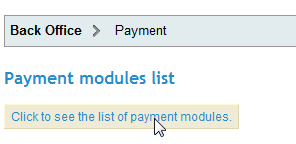
This button will send you directly to the correct module section. Here is the full list of payments modules included in the default PrestaShop install.

Find the "Cash on delivery (COD)" module in the list (third row). To install it, you just need to click on the "Install" button.

We are now going to look over how to set up and handle these modules, which are absolutely essential to your online store.
Click "Install" for the module, if it's not already the case. A "Configure" link appears below the module's name. Click it: a form appears, asking for some information.

In order for the module to accept bank wires, you need to fill out the address of the bank that your store uses. Once all of the fields are filled out, click "Update settings" to save your data.
Your customers will now see it appear in the store's Front Office as part of the available payment methods.

Your customers can choose the "Pay by bank wire" method. They need to click it to see the next page.
They will be asked for their choice of currency.

When clicking on the "I confirm my order" button, your bank information appears.
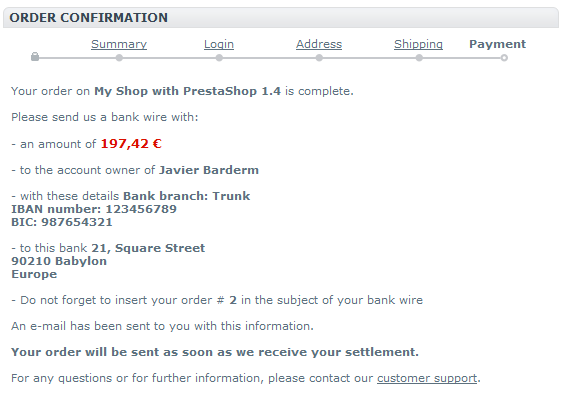
Your customer's order will appear directly in the orders summary, under the "Orders" tab.
When you receive the customer's bank wire, you must manually change the payment status of the order in your Back Office. This is different from a credit card order, where the payment is carried out automatically.
To configure payment by check, you need install the Check module (if it's not already done). Click "Install" for that module in the payments modules list. You now need to configure it.
Click the "Configure" link under the name of the module. The configuration form appears.

Indicate to whom your customer must make the check payable and your address then save by clicking on "Update settings".
This information will appear to the user at the end of the ordering process, after clicking the "Pay by check" option, and validating with a click on the "I confirm my order" button.

Your customer's order will appear directly in the orders summary, under the "Orders" tab.
When you receive the customer's check, you must manually change the payment status of the order in your Back Office. This is different from a credit card order, where the payment is carried out automatically.
PrestaShop offers several partner payment modules:
In order to use these modules, click on the "Install" button in the payments module list.
You will then see a "Configure" link under the installed module. Click it, and follow the instructions.
Authorize.net is a "Payment gateway enables Internet merchants to accept online payments via credit card and e-check."
You must have an Authorize.net account in order to use this module. You can access the website by clicking the Authorize.net logo in the module's configuration page (right of the page).

Once you have an account, follow the instructions provided by the module: fill in the fields with your information, and click "Update configuration".
Hipay is a safe and effective solution to pay, be paid online and bill all types of products, contents and - or services: digital, physical goods, download...
You must have a Hipay account in order to use this module. Use their online form.

Once you have an account, follow the instructions provided by the module: fill in the various fields with the information Hipay provided you with, and finally, click the "Update configuration".
The Kwixo module makes it possible for your shop to accept payments through Kwixo's own payment service. Kwixo is part of FIA-Net, the French e-commerce trust seal, and two major French banks, Crédit Agricole and LCL. Customers need to have a Kwixo account, and to have registered a credit card on their service.
You must have a Kwixo account in order to use this module. You can reach the sign-up form by clicking on the link in the configuration page.
Then, configure the module with your Merch Id, you Crypt Key, and indicate whether you want to work in Test mode for now, the type of payment you want to accept, and your delay for delivery.
From there on, complete the configuration information by indicating your main product types in the "Information on products sold on your shop" section, and your carrier types in the "Carrier Configuration" section.
Once the settings are in place, your customers will see the "Kwixo" option appear in the shop's front-office as part of the available payment methods.
As a merchant, you have access to a Kwixo-specific back-office at the URL located in the "Manage your payments in your Kwixo administration interface" section.
Eliminate expensive and unnecessary gateway fees by partnering with Merchant Warehouse for your payment processing needs!
Moneybookers is "the cheaper way to send and receive money worldwide. Secure and convenient online payments."
You must have a Moneybookers/Skrill account in order to use this module. Use this PrestaShop partner link for special rates.

Once you have an account, follow the instructions provided by the module: fill in the various fields with the information Moneybookers provided you with, check the boxes that are relevant to you, and finally, click the "Update configuration".
Ogone is "a leading independent payment service provider (PSP). Catering for businesses of all sizes, Ogone makes accepting payments online, simple, fast, secure and profitable."
You must have an Ogone account in order to use this module. Use their online form.

Once you have an account, follow the instructions provided by the module: fill in the various fields with the information Ogone provided you with then click the "Update configuration".
PayPal is "the faster, safer way to send money, make an online payment, receive money or set up a merchant account."
You must have a PayPal account in order to use this module. Use their online form.

Once you have an account, follow the instructions provided by the module: fill in the various fields, then click the "Update configuration".
Module for accepting payments in Latin American countries from local credit cards, local bank transfers and cash deposits.

Stripe (https://stripe.com/prestashop) is a premier online payment solution that offers something many competitors do not… simplistic transparency.
Getting started with Stripe is as easy it gets. For those using PrestaShop v1.4, simply download the free Stripe module from our Addons store and then install it into your Back Office under the "Modules" tab. You can find the module here: http://addons.prestashop.com/en/payments-gateways-prestashop-modules/6611-stripe.html
Once the module has been installed, you will need to configure it. This process has been streamlined and made simple so every online merchant can start using Stripe in minutes.
After clicking configure, you will need to create a free Stripe account. Simply enter your email address and choose an account password. From there, you will need to confirm your email before entering Stripe's dashboard (Check your chosen email's inbox for the required URL.)
After your email address has been confirmed, you will automatically be logged into the Stripe dashboard. From here, you will need to enter your business' information under "Your Account" settings (top right hand corner of the dashboard). Fill out the required fields while paying particular attention to the bank information at the bottom of the form. Once complete, click "Save."
You will now need to copy and paste the API Keys into the module itself. Both the "Test" and "Live" API Keys can be found under "Account Settings" in the Stripe dashboard. After copying them into the module, click "Save." Once complete, you will be ready to start accepting secure online payments from customers in USD or CAD. It's that easy.
Allow your customers to pay from their online bank account directly in your web-shop. The only payment method in Spain with 90% bank coverage.
The weXpay module makes it possible for your shop to accept payments through weXpay's own pre-paid system. weXpay is a French solution.
You must have a weXpay account in order to use this module. You can contact their team using the information in the "Contactez l'équipe weXpay" section on the right.
Then, configure the module with your weXpay merchant ID.
You can find more information on the configuration by reading the weXpay PDF, found under the "Pour plus d'infos, cliquez-ici" link at the bottom.
Once the settings are in place, your customers will see the "weXpay" option appear in the shop's front-office as part of the available payment methods.
When in the "Payment" tab, you can see the following section:
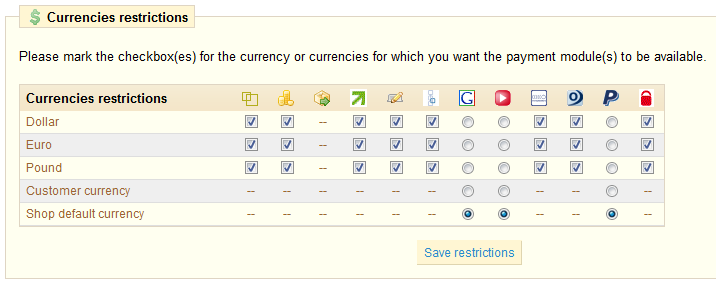
As you can see, depending upon the payment, the customer's choice of currency will differ:
Another option is that you can only accept payment with the store's default currency (which you can set in the "Payment" tab, "Currencies" sub-tab, "Currency options" setting).
You can limit the choice of payment method depending on the group of customers.

For instance, let's say you would prefer that individuals pay with PayPal, Moneybookers and Hipay, while professionals only pay by bank wire. Depending on the type of customer and on your choices, customers will only pay using the methods that match with your decisions.
You can limit the choice of payment methods according to your customer's country of origin. For instance, in France, Spain, and Germany, you can accept all payment methods, while customers in Italy, the United Kingdom or Switzerland can only pay by bank wire.
The choice of payment modules according to country is found under the "Payment" tab, in the "Countries restrictions" section.
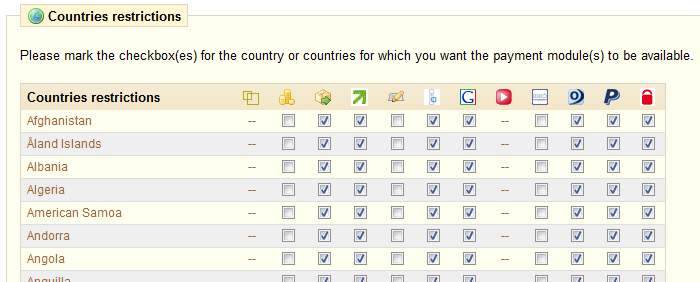
Find the country in the alphabetical list, and check the boxes to select or deselect the payment methods you want to make available to customers from that country. Once all of your settings have been configured, click on the "Save restrictions" button, found at the bottom of the table.
PrestaShop can accept a large number of currencies. By default, there are three standard currencies: The Euro, the Dollar, and the Pound. However, you can add and configure new currencies by clicking on the "Currencies" sub-tab, under the "Payment" tab.

Click on "Add New" to create a new currency and fill out the form (see the next page).
The two last sections of the "Currencies" sub-tab are very simple:
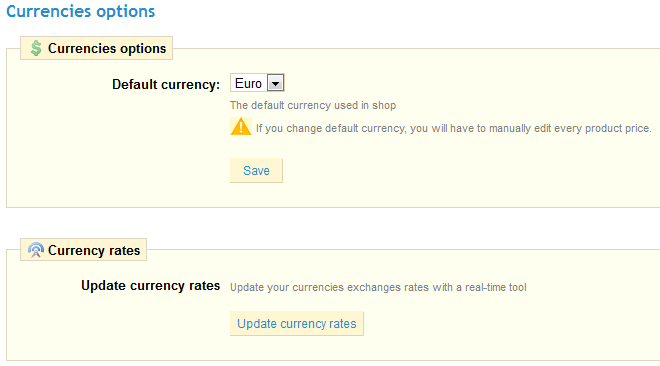
When you want to add another currency, simply click on the "Add New" button seen in the previous screenshot, and this form will appear:

Once the new currency is added, click "Save" to save your settings
The "Taxes" sub-tab, located under the "Payment" tab, enables you to manage the applicable taxes. Click on this tab to see the list of taxes. Three taxes are set up by default.
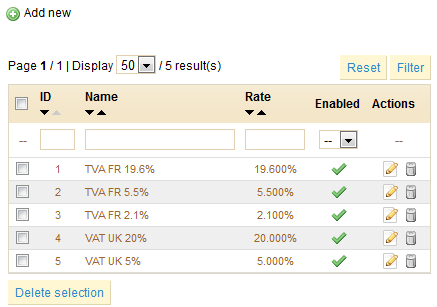
This sub-tab also gives you access to a set of options, which apply to the whole store and all of the orders.

If an ecotax does apply, a new field will appear in the product creation page:
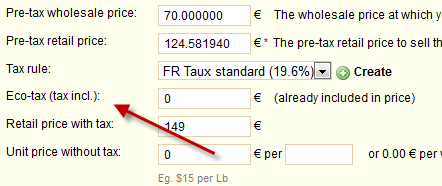
If you decide to take the ecotax in consideration after having added products, you will have to edit them in order to set the tax properly for each product.
The ecotax will also appear to the customer, on the product's page:
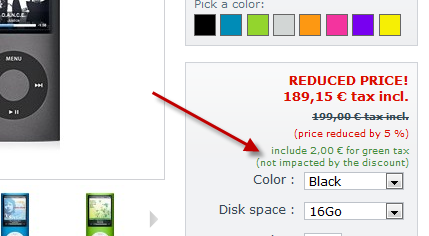
When you want to add another tax; simply click on the "Add New" button seen in the previous screenshot, and this form will appear:

Fill in the name of the tax ("TVA", for example), and its rate (in the XX.XX format), and save.
Note: It is a good idea to add reminders within the name, such as the country/group/zone the tax applies to, and its rate; this can help remembering which tax is to be applied to a given product.
Be default, a tax applies to all groups and countries/states/zones. If you wish to apply a particular tax to a country or set of countries (and not some others), you must create a tax rule for it. To that end, go to the "Tax Rules" sub-tab.
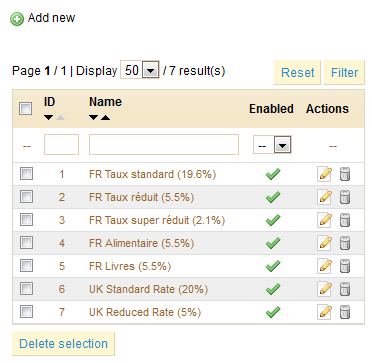
A few sample tax rules are already in place, which you can edit to get a better grasp of how things work. Let's create a new tax rule altogether. Click on "Add New".
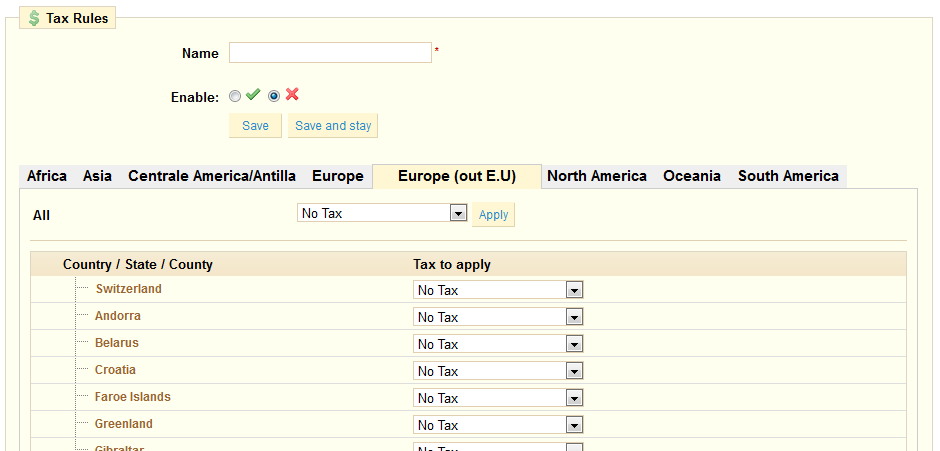
Note that the default rate applied to your product will be based on your store's default country.
In the "Vouchers" tab, you can give your customers discounts (by value or by percent) or offer free
shipping on their orders. Under this tab are all of the previously created vouchers, along with their
status of validity.
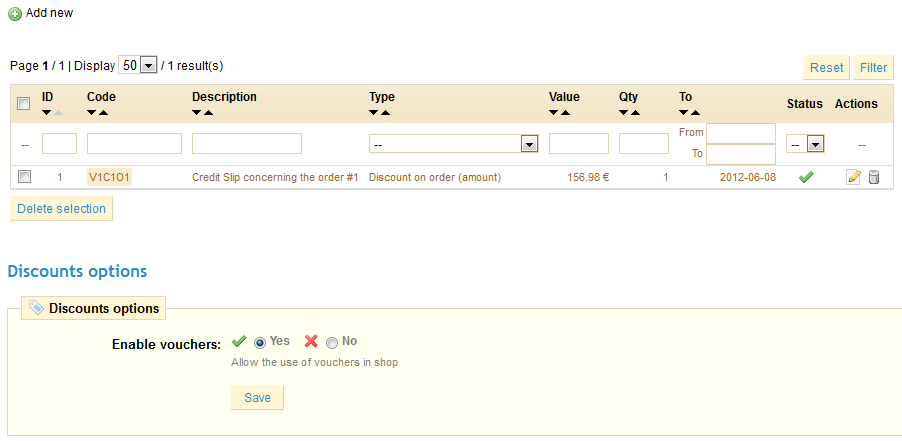
You can also enable/disable vouchers at the bottom of the screen.
Vouchers can be created automatically after a product return, but you can create a new voucher at any time manually, and be very specific about its properties.
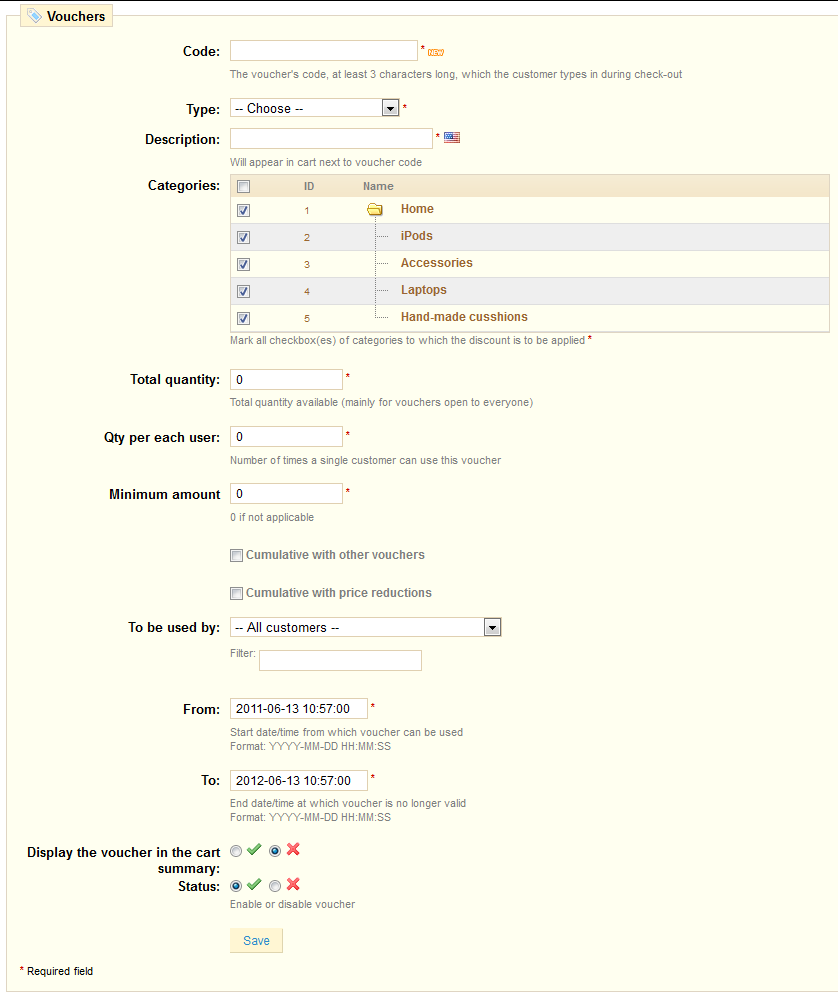
Once everything has been saved, you can send your voucher to your customers.
Your voucher will appear in the "Vouchers" tab, and you can delete or edit it at any time. If the voucher was set to a specific group or customer, then it will appear in the Front-Office, in the customer's "Vouchers" section of his account:

...as well as in the cart (if you chose to), where they can choose which one to apply to their order:

Vouchers that are set to apply to all customers do not appear in these locations: the customer has to know about them in order to use them.
In order to apply the voucher, the customer needs to visit his cart and enter the voucher in the suitable field and click "Add". The customer won't be able to apply the voucher if he checks out immediately.
Once applied, the cart summary displays the voucher's impact on the order's amount:
